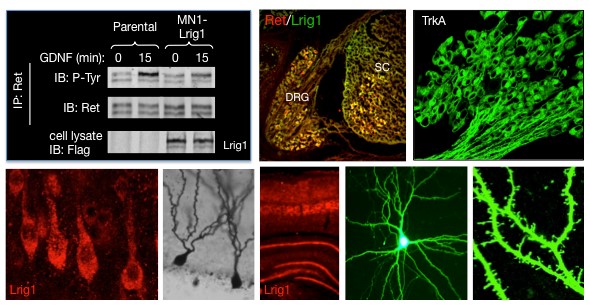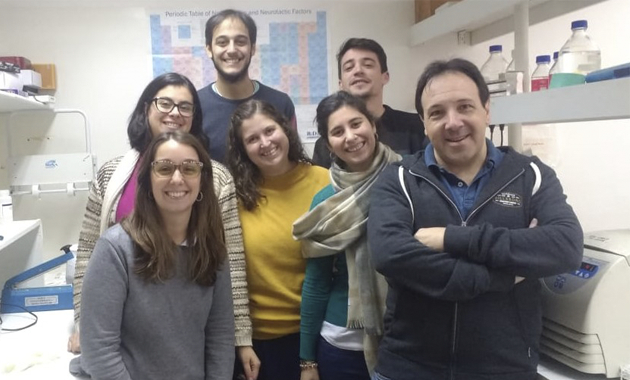

Contacto: gparatcha@fmed.uba.ar Tel: 5285-3181
Fernando Federicci, Becario doctoral ANPCyT.
Antonella Ríos, Becaria doctoral CONICET (Co-Director)
Facundo Ferrero-Restelli, Becario posdoctoral ANPCyT
Micaela García, Becaria Posdoctoral CONICET
Antonela Bonafina, Docente FMed, posdoc
Dr. Håkan Hedman, Universidad de Umeå, Suecia.
The development of the nervous system is determined by a complex and intricate interplay between intrinsic cellular programs and extrinsic cues located in the neural environment. Within this broad context, my group is interested in understanding the functions and signaling pathways through which trophic factors and their receptors regulate the proliferation of neural stem cells, modulate the migration of neuronal progenitors and determine neuronal growth, survival and ultimately synaptic maturation and plasticity. In addition, we are interested in understanding the physiological significance and the molecular mechanisms through which, a relatively novel family of transmembrane proteins containing leucine-rich repeats and Ig domains (LRIgs), modulates the activation of trophic factor receptors in neuronal progenitors and mature neurons. To achieve this, we use RNAseq technology, cellular, molecular and biochemical techniques, and in vivo models in gene-electroporated and transgenic mice. Undoubtedly, our ability to develop efficient therapeutic strategies for neurodegenerative diseases and neurological disorders will greatly depend on how well we understand the principles that govern the development and function of the vertebrate nervous system. Thus, our final goal is to reveal the mechanisms underlying the development of the nervous system, and thereby contribute to improve our knowledge of the diseases that affect it

PICT 2016-1512 Agencia Nacional de Promoción de la Ciencia y Tecnología. Argentina.
PICT 2017-4513 Agencia Nacional de Promoción de la Ciencia y Tecnología. Argentina.
PubMed: https://www.ncbi.nlm.nih.gov/pubmed/?term=Paratcha+G
h index: 24
Total de artículos publicados: 46
-De Vincenti AP, Ríos AS, Paratcha G, Ledda F. Mechanisms That Modulate and Diversify BDNF Functions: Implications for Hippocampal Synaptic Plasticity. Front Cell Neurosci. 13:135. doi: 10.3389/fncel.2019.00135 (2019).
-Bonafina A, Fontanet PA, Paratcha G, Ledda F. GDNF/GFRa1complex abrogates self-renewing activity of cortical neural precursors inducing their differentiation. Stem Cell Reports. doi: 10.1016/j.stemcr.2018.01.019 (2018).
-Lindquist D, Alsina FC, Herdenberg C, Larsson C, Höppener J, Wang N, Paratcha G, Tarján M, Tot T, Henriksson R, Hedman H. LRIG1 negatively regulates RET mutants and is downregulated in thyroid cancer. Int J Oncol. 52(4):1189-1197 (2018).
-Trinchero M; Buttner KA; Sulkes Cuevas JN; Temprana S; Fontanet PA; Monzón-Salinas MC; Ledda F; Paratcha G and Schinder AF. High plasticity of new granule cells in the aging hippocampus. Cell Reports 21(5):1129-1139 (2017).
-Fontanet PA, Ríos AS, Alsina FC, Paratcha G, Ledda F. Pea3 transcription factors, Etv4 and Etv5, are required for proper hippocampal dendrite development and plasticity. Cerebral Cortex. 28(1):236-249 (2018).
-Ledda F and Paratcha G. Mechanisms regulating dendritic arbor patterning. Cellular and Molecular Life Sciences.doi: 10.1007/s00018-017-2588-8. (2017).
-Alsina FC; Hita FJ; Fontanet PA; Irala D; Hedman H; Ledda F and Paratcha G. Lrig1 is a cell-intrinsic modulator of hippocampal dendrite complexity and BDNF signaling. EMBO Reports 17(4):601-16. doi: 10.15252/embr.201541218 (2016).
-Irala D, Bonafina A, Fontanet PA, Alsina FC, Paratcha G, Ledda F. GDNF/GFRa1 complex promotes development of hippocampal dendritic arbors and spines via NCAM. Development 143(22): 4224-4235 (2016).
-Ledda F and Paratcha G. Assembly of Neuronal Connectivity by Neurotrophic Factors and Leucine-Rich Repeat Proteins. Front. Cell Neurosci. (2016). doi: 10.3389/fncel.2016.00199
-Fontanet, P; Irala, D; Alsina, F; Paratcha, G and Ledda F. Pea3 Transcription Factor Family Members Etv4 and Etv5 Mediate Retrograde Signaling and Axonal Growth of DRG Sensory Neurons in Response to NGF. J Neurosci. 33(40):15940 -15951 (2013)
-Alsina F.C; Ledda F and Paratcha G. New insights into the control of neurotrophic growth factor receptor signaling: Implications for nervous system development and repair. J. Neurochem, (2012) 23(5):652-61. doi: 10.1111/jnc.12021.
- Alsina F.C; Irala, D; Fontanet, P.A; Hita, F.J; Ledda, F and Paratcha, G. Sprouty4 is an endogenous negative modulator of TrkA signaling and neuronal differentiation induced by NGF. PLoS ONE 7(2):e32087 (2012).
- Paratcha G and Ledda F. The GTPase-activating protein Rap1GAP. A new player to modulate Ret signaling. Cell Research. 21(2):217-9. (2011)
-Shirazi Fard, S; Kele, J; Vilar M; Paratcha, G and Ledda, F. Tiam1 as a signaling mediator of nerve growth factor-dependent neurite outgrowth. PLoS ONE 5(3): e9647 (2010)
-Nanou E, Kyriakatos A, Bhattacharjee A, Kaczmarek LK, Paratcha G, El Manira A. Na+-mediated coupling between AMPA receptors and KNa channels shapes synaptic transmission. Proc Natl Acad Sci USA 105(52) 20941-6 (2008).
-Hökfelt T, Stanic D, Sanford SD, Gatlin JC, Nilsson I, Paratcha G, Ledda F, Fetissov S, Lindfors C, Herzog H, Johansen JE, Ubink R, Pfenninger KH. NPY and its involvement in axon guidance, neurogenesis, and feeding. Nutrition. 24(9):860-8 (2008).
-Paratcha, G and Ledda, F. GDNF and GFR?: A versatile molecular complex for developing neurons. Trends in Neurosciences. 31(8).384-91 (2008).
-Stanic, D; Paratcha, G; Ledda, F; Herzog, H; Kopin, AS; Hökfelt, T. Peptidergic influences on proliferation, migration, and placement of neural progenitors in the adult mouse forebrain. Proc Natl Acad Sci USA, 4,105(9) 3610-5 (2008).
-Ledda, F; Bieraugel, O; Shirazi fard, S; Vilar, M; Paratcha, G. Lrig1 is an endogenous inhibitor of Ret receptor tyrosine kinase activation, downstream signaling and biological responses to GDNF. J. Neurosci. 2, 28 (1) 39-49 (2008).
-Disruption of the GDNF binding site in NCAM dissociates ligand binding and hemophilic cell adhesion. Sjostrand, D; Carlsson J; Paratcha G; Persson B and Ibanez CF. J Biol. Chem 282(17):12734-40 (2007).
-GDNF and GFRa1 promote formation of neuronal synapses by ligand-induced cell adhesion. Ledda F; Paratcha G; Sandoval-Guzman T and Ibanez CF. Nat Neurosci. 10(3): 293-300 (2007).
-Negative regulation of receptor tyrosine kinase (RTK) signaling: A developing field. Ledda F and Paratcha G. Biomark Insights 14; 2:45-58.
2014 Conferencista del simposio "Progress in Neurosciences: Degeneration and regeneration". 51 Congreso Argenino de Neurología-14-17 de octubre de 2014, Mendoza. Argentina.
2015 Conferencista invitado al 3rd South American Symposium of Signal Transduction and Molecular Medicine (SISTAM) meeting. Bariloche, Argentina.
2016 Conferencista invitado, III Taller de Biología Celular y del Desarrollo. 27-29 de Octubre, Chascomus, Argentina.
2018 Conferencista invitado. Symposio: "Transducción de Señales y Mecanismos Moleculares de Enfermedad". LXIII Reunión Annual de la Sociedad Argentina de investigación Clínica (SAIC). 14 -17/ November. Mar del Plata, Buenos Aires, Argentina.
Premio J.S. Guggenhein en Ciencias Naturales (2011), Area: Biología Molecular y Celular. https://www.gf.org/fellows/all-fellows/gustavo-paratcha/

